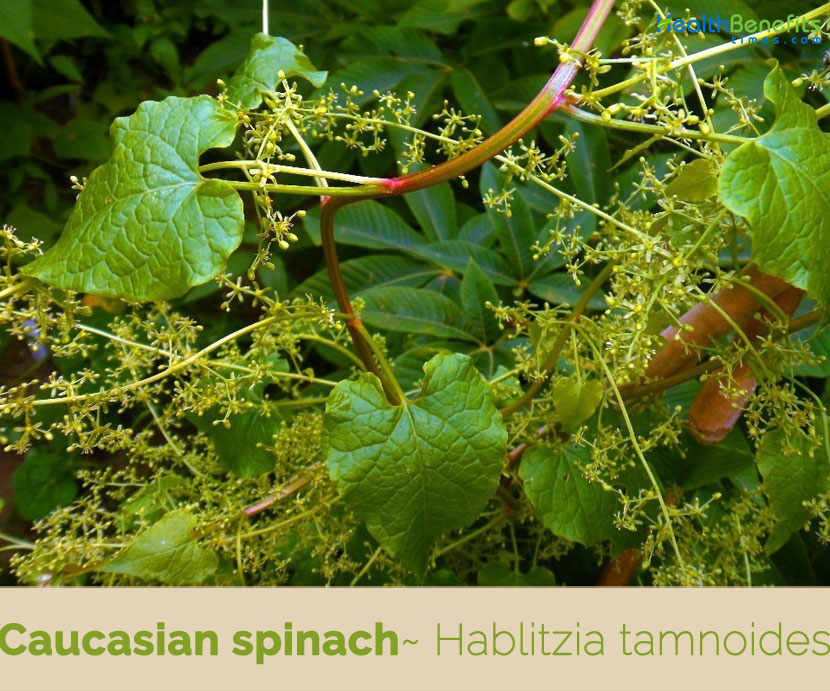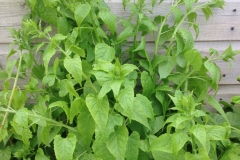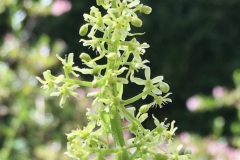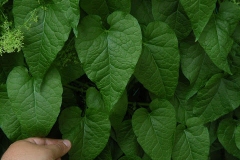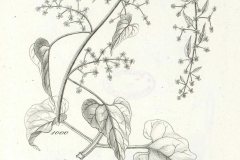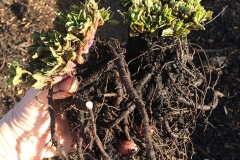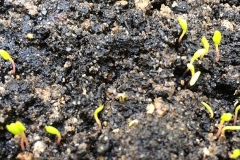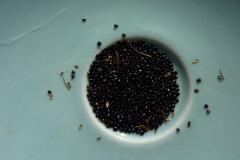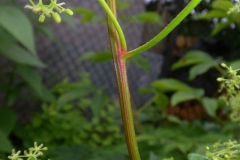| Caucasian spinach Quick Facts | |
|---|---|
| Name: | Caucasian spinach |
| Scientific Name: | Hablitzia tamnoides |
| Origin | Caucasus region |
| Colors | Green when young turning to red |
| Shapes | Plump, shiny berries |
| Name | Caucasian Spinach |
|---|---|
| Scientific Name | Hablitzia tamnoides |
| Native | Caucasus region |
| Common Names | Caucasian spinach, Caucasus spinach, Climbing spinach, Hablitzia, Spinach Vine, Rank Spinach |
| Name in Other Languages | Armenian: Hablits’ia (հաբլիցիա) Azerbaijani: Tamusşəkilli yalançı sarmaşıq Bokmal: Stjernemelde Bulgarian: Kavkazii shpinat (Кавказий шпинат) Chinese: Gao jia suo bo cai (高加索菠菜) Danish: Spinatranke Dutch: Kaukasus spinazie English: Caucasian spinach, Caucasus spinach, Climbing spinach, Hablitzia, Spinach Vine, Rank Spinach Finnish: Köynnöspinaatti French: Épinard grimpant du caucase German: Kaukasische Spinat Greek: Kuvkasos spanaki (Καύκασος σπανάκι) Italian : Spinacio del Caucaso, Spinaci di Caucasi Japanese: Kookasasu no horensou (コーカサスのホウレンソウ), Kookasasu no horensou (コーカサスのほうれんそう), Kookasasu no hourensou (コーカサスの菠薐草) Norwegian: Stjernemelde Polish: Szpinak kaukazki Portuguese: Espinafre de Cáucaso Russian: Gablitsiia tamusobidnaia (Габлиция тамусовидная) Spanish: Espinaca del Cáucasia, Espinaca del Cáucaso Swedish: Rankspenat Turkish: Ispanak Kafkasya, sarpancar |
| Plant Growth Habit | Long-lived, semi shade loving, herbaceous perennial climber |
| Growing Climates | Mesic woodland habitats especially spruce and beech woods in its native environment, among rocks and in ravines and along rivers |
| Stem | Generally green, with noticeable ridges running their length |
| Leaf | Green, heart-shaped leaves, often slightly crimped, but without serration or lobing, which taper to a narrow point, and sometimes have very soft, almost silky hairs on them |
| Flowering season | May through July |
| Flower | Individually quite small, a lighter green than the foliage, perhaps greenish-yellow, and like little five-pointed stars |
| Fruit Shape & Size | Plump, shiny berries |
| Fruit Color | Green when young turning to red |
| Seed | Tiny, kidney shaped, flattish, biconvex, edge rounded, smooth, glossy black. |
| Propagation | By seed or by vegetative propagation |
| Other Facts |
|
Leaves
Caucasian Spinach has green, heart-shaped (cordate) leaves, often slightly crimped, but without serration or lobing, which taper to a narrow point (acumiate), and sometimes have very soft, almost silky hairs on them. Hablitzia’s leaf-surface is more or less matt, and the veins are arranged around a single, central axis. The leaves are edible, similar to those of the related spinach.
Flowers
Hablitzia flowers are individually quite small, a lighter green than the foliage, perhaps greenish-yellow, and like little five-pointed stars, a fact that is reflected in the Norwegian name, Stjernemelde, which means Star-chenopod. They are borne profusely in a racemose, paniculate and/or thyrsoid arrangement. The flowers appear from late May through July. The flowers have a noteworthy quality, and that is their scent. Individually it isn’t particularly pronounced. Even when flowers abound, you probably wouldn’t notice it from any great distance. But if you draw close to a particularly floriferous Hablitzia, you might notice the air filled with scent almost exactly like crushed Coriander (Cilantro) leaf – rather unpleasant.
Fruits
However, they have six rather than five petals, and are followed by plump, shiny green berries that ripen to red (and should be handled with care, as the pulp contains minute, needle-like calcium oxalate crystals, known as raphides). Hablitzia on the other hand produces tiny, glossy black seeds, sometimes in abundance.
Culinary uses
- Edible greens and shoots can be consumed raw or cooked.
- Leaves are also used in soups, pies, pizza, Indian and oriental food.
- Young shoots can be eaten.
- Leaves, the young shoots, the tender vine tips and the emerging inflorescence can be used as a vegetable, again raw or cooked.
Recipes
Homemade Caucasian Spinach Pizza
Ingredients
- 350 g Strong White Bread Flour
- Olive Oil
- 2 tsp. Dried Active Yeast
- 1 Tin/Carton Chopped Tomatoes
- A few handfuls of Hablitzia
- A handful of Golden Garlic (Allium moly) Flowers (or similar)
- 1/4 of an Aubergine
- A few Baby King Oyster Mushrooms
- 1 Large Red Onion
- A handful of Kalamata Olives
- 1 Carrot
- Tobasco Sauce (to taste)
- Golden Marjoram (a couple of sprigs)
- Rosemary (a couple of sprigs)
- Lovage (a few leaves)
- Salt (a pinch)
- Black Pepper (to taste)
Directions
- Start by dissolving the yeast in about 150 ml water. Leave this to stand for half an hour or until it develops a good head of foam. Pour (or if you prefer, sift) your flour into a large mixing bowl. Add the salt and a dash of oil, then make a small well in the center and begin stirring in the water/yeast. Keep stirring until the mix is even, and leave to stand for another forty minutes of so, or until the dough has doubled in size. It can help to wipe a bit of oil on the inside of the bowl so that the dough doesn’t stick as it rises.
- Press the dough down to knock the largest air bubbles out of it, then turn onto a pre-floured surface and knead well. Then leave to one side while you make the sauce.
- Peal the carrot and chop it finely. Chop 3/4 of the onion finely as well, and put the other 1/4 aside. Add some oil to a pan, and when hot add both. Simmer on a low heat until they are soft, and then add the tomatoes. Turn the heat up slightly, and bring the sauce back up to temperature, then cook for 10 minutes or so.
- Chop the herbs finely, and add them, with a pinch of salt, some black pepper, and a dash of Tobasco sauce, then cook for another couple of minutes.
- Cut the Aubergine, the Mushrooms, and the remaining 1/4 Red Onion, then put to one side (although not necessary, I actually decided to heat some oil in a pan and turn the Aubergine and Mushroom in this a few times, to coat them ready for crisping up in the oven).
- Stretch (or roll) your base to size. Transfer this to a baking tray or a pre-heated Pizza Stone. Add the sauce, and the toppings apart from the Golden Garlic and Hablitzia. Then place in a pre-heated oven on the middle shelf at 200-220°C
- Keep an eye on your pizza while it cooks, and a few minutes before it is ready add the Golden Garlic flowers, the Hablitzia and a drizzle of nice Olive Oil. When ready, remove from the oven and serve.
References:
https://pfaf.org/user/Plant.aspx?LatinName=Hablitzia+tamnoides
https://npgsweb.ars-grin.gov/gringlobal/taxonomydetail.aspx?id=454981
https://davesgarden.com/guides/pf/go/194268/#b
https://www.esculents.co.uk/caucasian-spinach-hablitzia-tamnoides/
https://gd.eppo.int/taxon/HBLTA
https://en.wikipedia.org/wiki/Hablitzia


